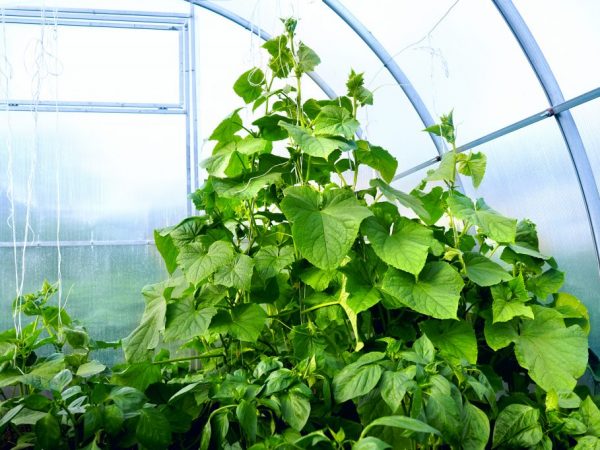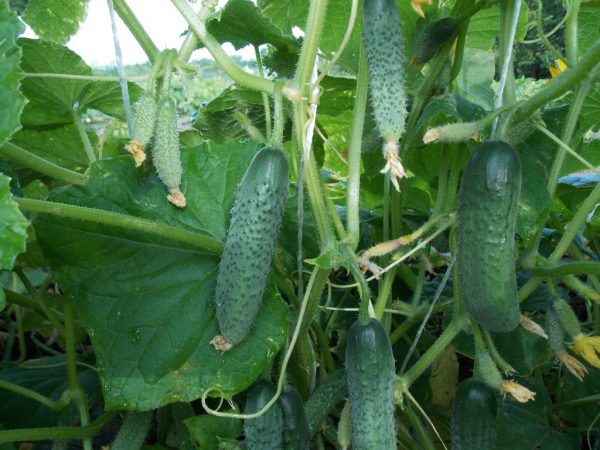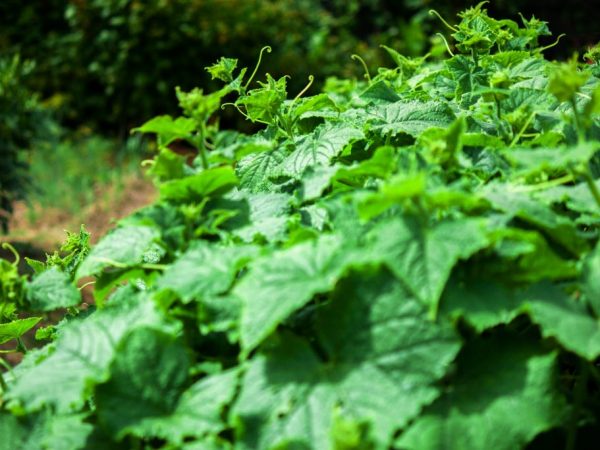Description of Kustovoy cucumbers
There are no vegetable gardens in which cucumbers are not grown. This vegetable is good both in fresh salads and in preservation. Due to its low calorie content, its greens can be eaten during the diet in any quantity. The Kustovaya cucumber variety is a prominent representative of this culture.

Description of Kustovoy cucumbers
Its compactness allows for excellent harvests even in the smallest areas. The plant does not require special care, it also grows well in almost any soil.
Characteristics of the variety
Bush cucumber is an early ripening variety. The period from the appearance of the first shoots to the beginning of fruiting is 46-47 days. This figure may vary slightly, depending on the weather and region of growth. Since the flowers are pollinated by insects, the variety is not suitable for growing in plastic shelters and greenhouses.
Description of the bush
The official description shows that bush cucumbers have an unusual shoot structure for this plant. Their lashes are greatly shortened and do not grow longer than 50 cm. The leaves are planted closer to each other, but have a smaller size. Lateral shoots are actively forming, forming a bushy shape.
In favorable growing conditions, the ovary is laid after each leaf. Female flowers predominate, which allows for a much larger yield. The yield is 3-3.5 kg per 1 m².
Description of fruits
A bush cucumber can be harvested as early as June, and by the middle of the month it fully enters the fruiting period. Zelentsy must be harvested daily, as they grow rapidly.
Characteristics of cucumbers:
- small, 8-12 cm in size;
- have a dense skin;
- covered with a large number of tubercles with a black apex;
- tolerate transportation well;
- not prone to bitterness.
The texture of the flesh is dense and crunchy, so they are used raw, as well as for making salads, sandwiches and cold soups. The dense skin allows the fruit to remain strong after pickling, pickling and fermentation. Overgrown specimens are used to prepare canned salads. You can collect greens at the stage of ripeness. These little cucumbers look great in dishes.
Growing

This variety can be grown twice per season.
Bush cucumber varieties are not very picky about care, but they need timely watering and feeding. Due to its early maturity, the variety can be planted 2 times per season. The first time is in April, and the second time is in July.
Seed preparation
To get a healthy planting, you need to choose the right seed. Seeds from large producers, such as Aelita, conduct a thorough analysis of their products for the presence of pathogens. Buying seeds in bulk, the summer resident risks bringing mold spores into the ground.
Bush cucumber varieties are widely available on the market. In addition to the classic, you can choose other analogs of culture. They showed themselves well:
- Chelyabinsk undersized;
- Shorty;
- Kid;
- Kid F1.
Before planting, the seeds are soaked in a warm solution of potassium permanganate for additional disinfection for 15-20 minutes. You cannot leave them in the liquid longer, otherwise the cotyledons may rot.
Landing
Since the cultivation of bushes takes place in the open field, there are two ways to plant plants. The first is to plant seedlings in mid-April. For this, 2-3 seeds are placed in separate containers with a nutrient substrate. The first shoots appear 5-7 days after planting. The earthen lump must always be kept moist, and after watering, carefully loosen the soil without touching the delicate roots of the seedling. In May, the seedlings are transplanted to a permanent place.
The agricultural technique for planting seeds directly into the ground is slightly different. This is done a little later, in mid-May, when the danger of return frosts has passed. The optimal planting pattern is 30 cm between plants and at least 50 cm between rows.
The beds must be prepared in advance. In order for the culture to grow well and bear fruit, during autumn digging, rotted horse, cow or bird droppings are introduced into the soil. In the spring, wood ash is poured into the holes.
Watering
Bush cucumbers, like their tall relatives, need constant moisture. It is recommended to water them either early in the morning or in the afternoon. In hot weather, fumes from wet ground can injure fruits and leaves.
The bush should not be watered with cold water. If watering is done from a well, it is recommended to install special containers. The sun's rays during the day will warm up the water in them, and in the evening it can already be poured into the beds. Violation of this simple rule leads to the development of root rot and death of the plant.
Water is poured strictly at the root. It is undesirable to get it on the leaves and shoots of the plant. After that, the earth is carefully loosened.
Fertilizers
A bush-type cucumber in the process of growth, during the period of setting and ripening of fruits, needs additional feeding. A week after the appearance of the first shoots, the beds are fertilized with potash fertilizers. This enables young plants to quickly gain growth, and also strengthens the root system. If the cucumbers are grown in seedlings, fertilizer is applied a little earlier for the first time.

Plants need periodic fertilization
Top dressing is carried out in certain phases of the growing season of plants. In the process of leaving, it is better to fertilize them at the following time:
- During the period of active growth of a young shoot: mix 10-15 g of ammonium nitrate, 15 g of potassium chloride and 20-30 g of superphosphate. Fertilizers are dissolved in 10 liters of water and gently watered with this plant.
- The period of flowering and the formation of ovaries: take 0.5 liters of infused mullein in a bucket of water (insist 10-14 days) and 1 tbsp. l. nitrophosphate. If the plant does not bloom well, it is recommended to add 0.5 g of boric acid to the solution.
- Ripening period of zelents: ash is mixed with 1 liter of herbal infusion and 10 liters of water are poured. To obtain an infusion, any herb that has not reached flowering is finely chopped, placed in a container and poured with water. The fermentation process takes 7-10 days.
Before fertilizing, the beds are well watered with water to avoid burns of the rhizomes with the components of the top dressing. In addition to root fertilization, gardeners also use foliar fertilization. In this case, the plant is sprayed with a nutrient mixture. Superphosphate, boric acid, potassium nitrogen and zinc sulphide are mixed and diluted with water. Such spraying should not be done in very hot weather.
Diseases and pests
Bush cucumbers are less susceptible to disease. They are resistant to various types of rot, including root rot, and do not suffer from bacteriosis. All the best qualities have been combined in this variety through many years of selection.
Diseases and the fight against them
Plants are susceptible to powdery and downy mildew. The causative agents of these diseases are parasitic fungi. The surface of leaves and greens is covered with gray-brown spots.In structure, they resemble felt or velvety fabric. The disease quickly affects healthy specimens and can destroy all plantings in a fairly short time.
They fight powdery mildew with regular milk whey or skim milk. It is sprayed onto the surface of leaves and shoots. By the same principle, they are treated with a solution of laundry soap.
Also, fungicides are used in the fight against diseases of cucumbers. Topaz, HOM, Fitosporin, Quadris - these names are known to every gardener.
Pests and the fight against them
Landings can be damaged by insects, as well as by their larvae. The greatest harm to the economy is caused by aphids. These small winged pests suck out plant juices and cause them to wilt and die. Affected specimens are powdered with wood ash and crushed chalk in a 1: 1 ratio.
The spider mite is also not a rare guest in the cucumber garden. It actively reproduces in too moist soil and thickened plantings. The whole bush is covered with thin white cobwebs produced by the insect's glands. Get rid of it with fungicides. In order to prevent its appearance in the fall, the beds are sown with mustard as a siderat.
Conclusion
Growing bush cucumbers does not require special skills and a lot of experience. They are easy to care for and produce excellent yields. In the southern regions, when the variety is grown in two passes, the last harvests are taken at the end of September, which allows you to enjoy crispy greens throughout the summer.
The versatility of the fruit has also played a role in the popularity of the variety. They are good both fresh and canned. When fermented, the greens do not lose their shape and remain crispy.


